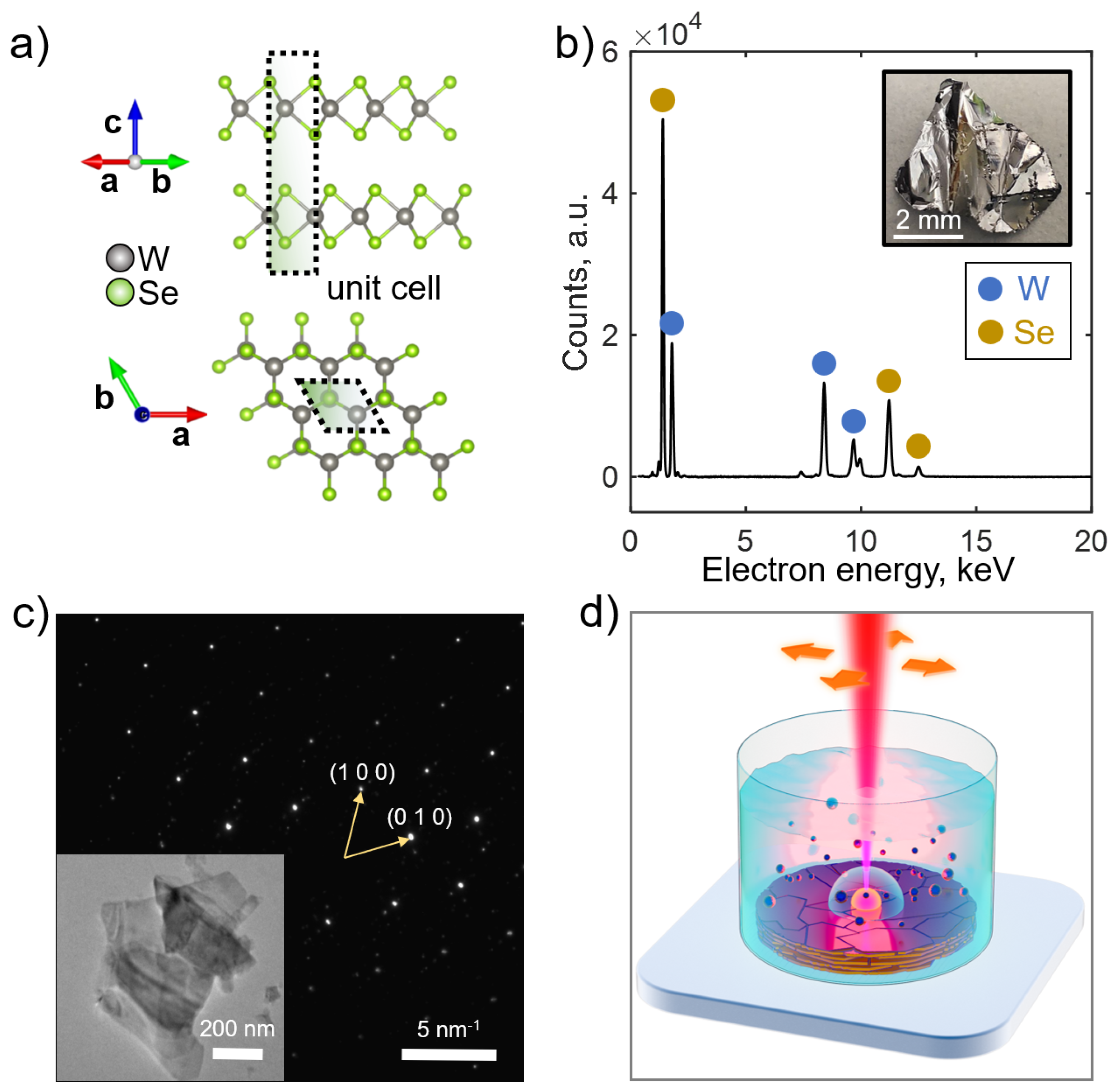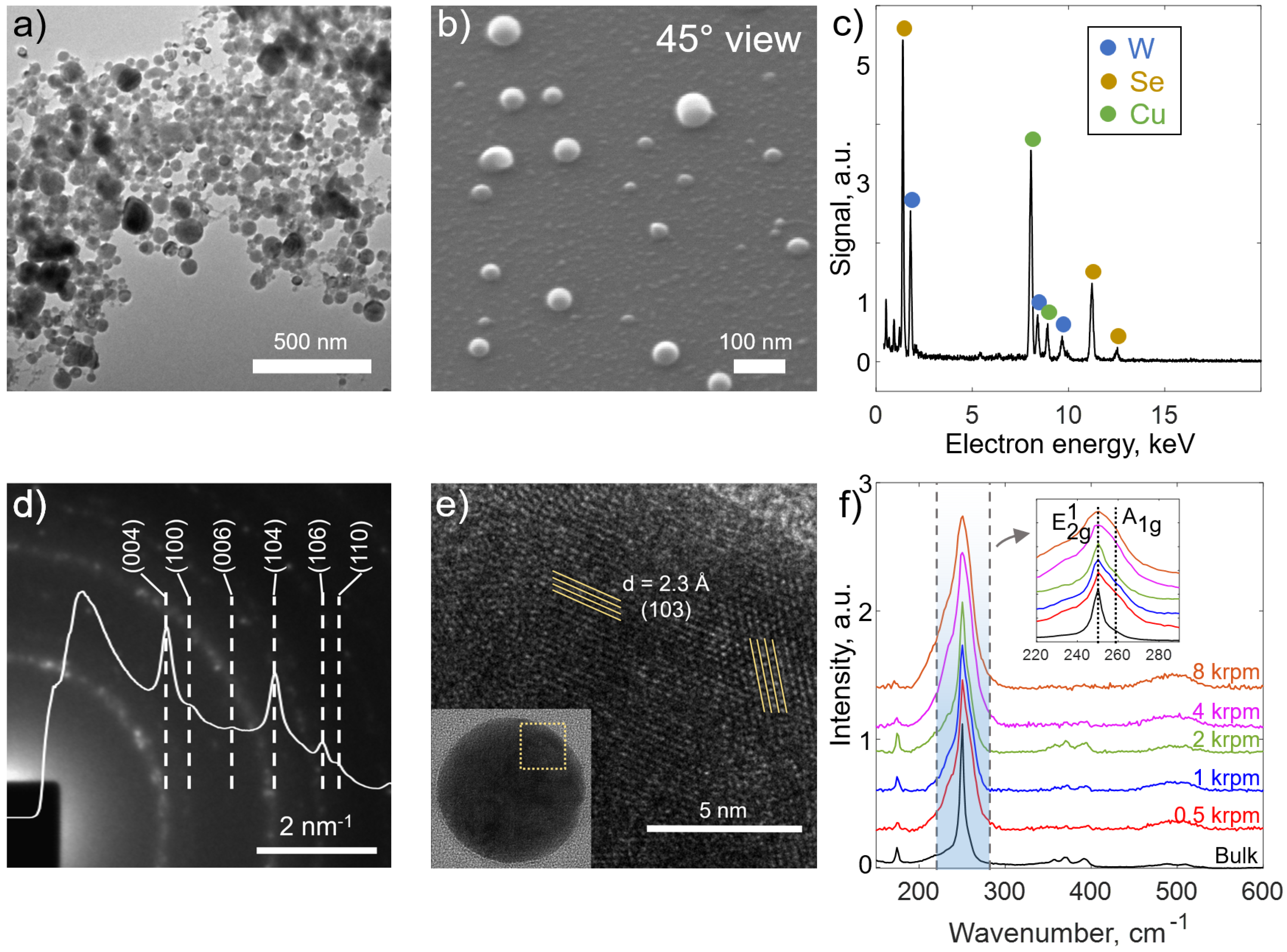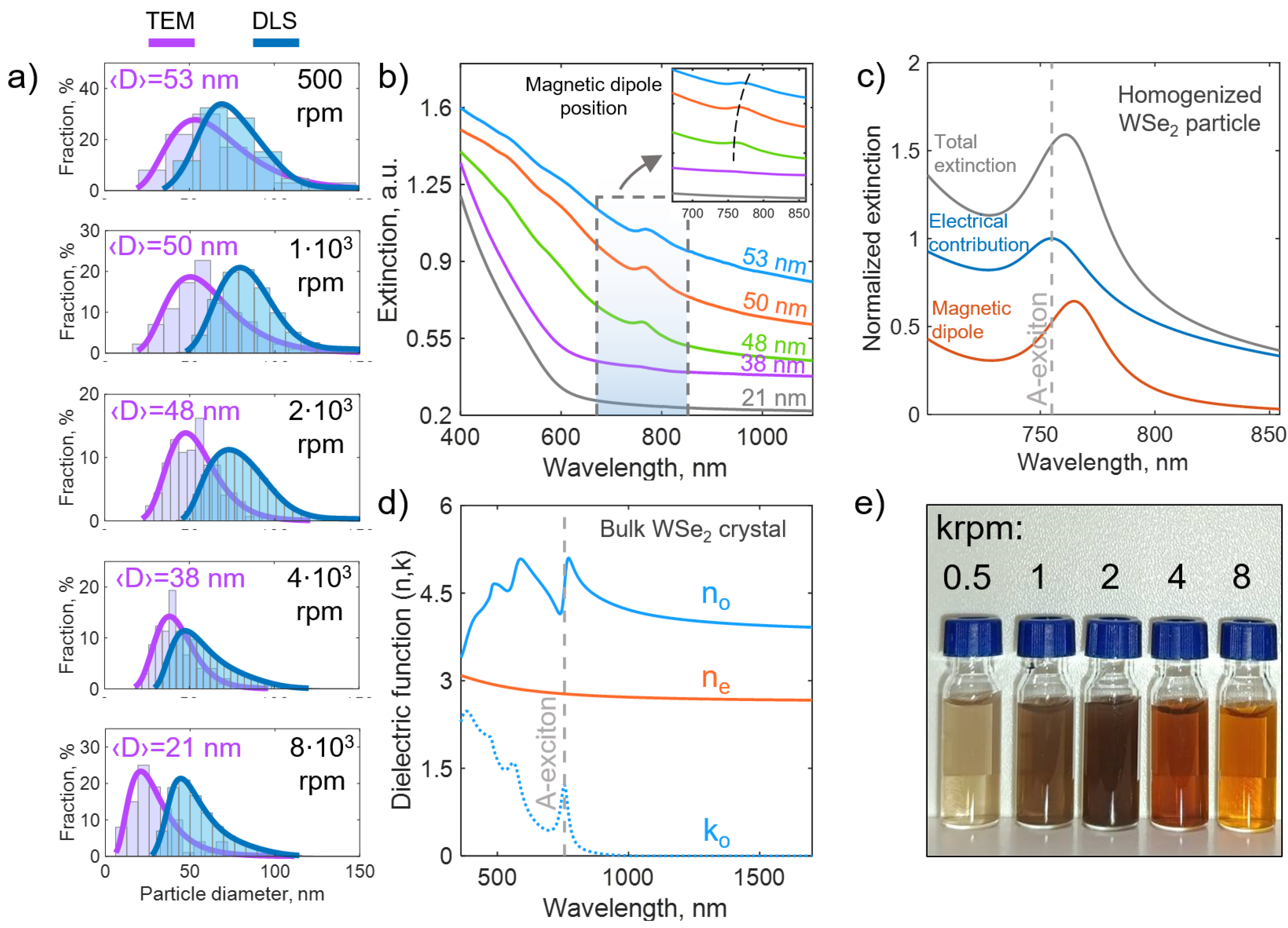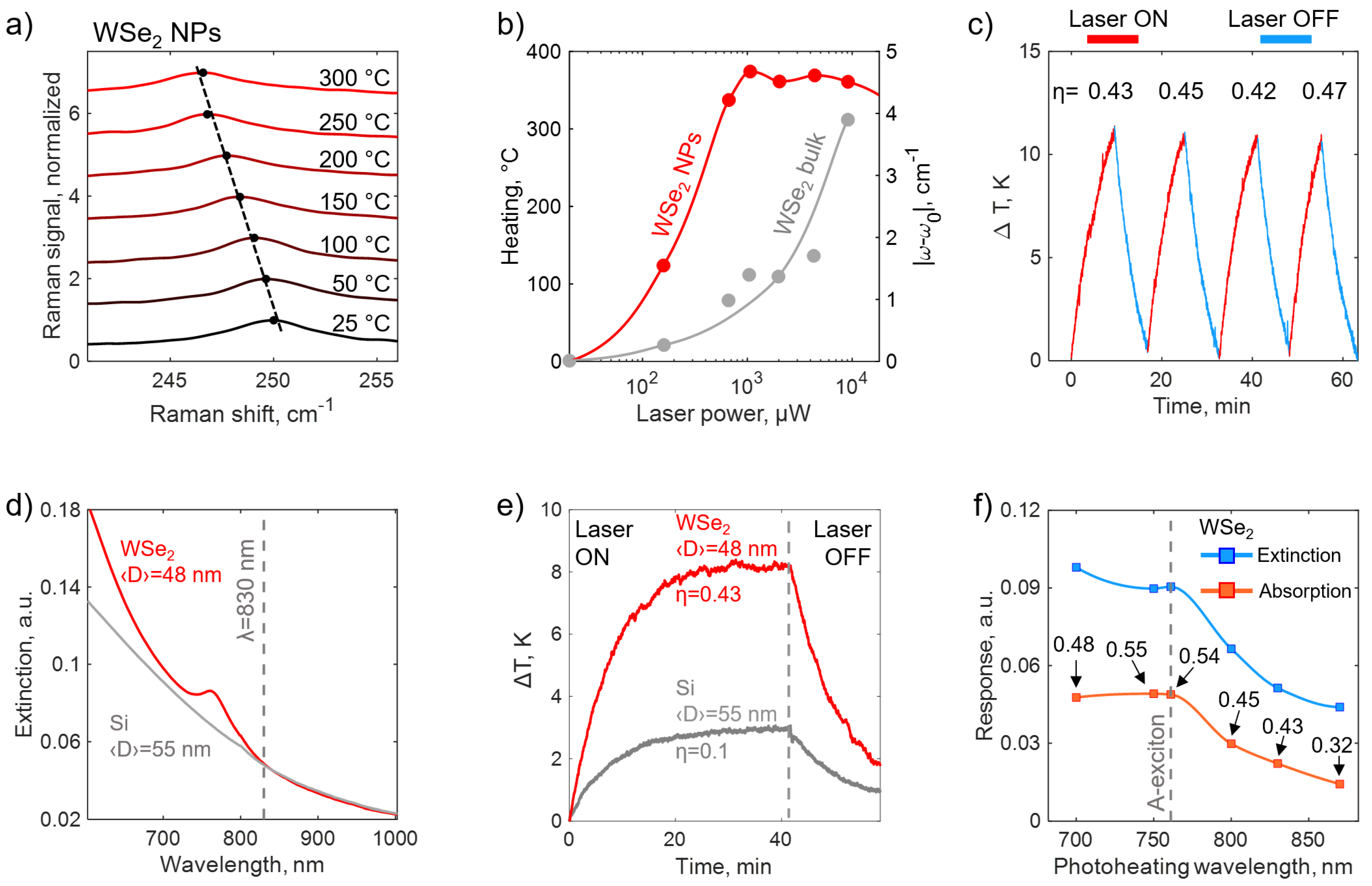Tungsten Diselenide Nanoparticles Produced via Femtosecond Ablation for SERS and Theranostics Applications
Abstract
:1. Introduction
2. Materials and Methods
2.1. Sample Preparation
2.2. Sample Characterization
3. Results and Discussion
3.1. Laser Ablation Synthesis of WSe2 NPs
3.2. Morphology of WSe2 Nanoparticles
3.3. Optical Response of WSe2 Nanoparticles
3.4. Photothermal Applications of WSe2 Nanoparticles
3.5. WSe2 NPs for SERS
4. Conclusions
Supplementary Materials
Author Contributions
Funding
Data Availability Statement
Acknowledgments
Conflicts of Interest
Abbreviations
| TMDC | Transition metal dichalcogenide |
| NP | Nanoparticle |
| PLAL | Pulsed laser ablation in liquid |
| SEM | Scanning electron microscope |
| TEM | Transmission electron microscope |
| SAED | Selected area electron diffraction |
| EDX | Energy-dispersive X-ray spectroscopy |
| SERS | Surface-enhanced Raman scattering |
| R6G | Rhodamine 6G |
| CV | Crystal violet |
References
- Novoselov, K.S.; Geim, A.K.; Morozov, S.V.; Jiang, D.E.; Zhang, Y.; Dubonos, S.V.; Grigorieva, I.V.; Firsov, A.A. Electric field effect in atomically thin carbon films. Science 2004, 306, 666–669. [Google Scholar] [CrossRef] [PubMed]
- Hossen, M.F.; Shendokar, S.; Aravamudhan, S. Defects and Defect Engineering of Two-Dimensional Transition Metal Dichalcogenide (2D TMDC) Materials. Nanomaterials 2024, 14, 410. [Google Scholar] [CrossRef] [PubMed]
- Falin, A.; Holwill, M.; Lv, H.; Gan, W.; Cheng, J.; Zhang, R.; Qian, D.; Barnett, M.R.; Santos, E.J.; Novoselov, K.S.; et al. Mechanical properties of atomically thin tungsten dichalcogenides: WS2, WSe2, and WTe2. ACS Nano 2021, 15, 2600–2610. [Google Scholar] [CrossRef] [PubMed]
- Zhao, Y.H.; Yang, F.; Wang, J.; Guo, H.; Ji, W. Continuously tunable electronic structure of transition metal dichalcogenides superlattices. Sci. Rep. 2015, 5, 8356. [Google Scholar] [CrossRef]
- Ermolaev, G.A.; Stebunov, Y.V.; Vyshnevyy, A.A.; Tatarkin, D.E.; Yakubovsky, D.I.; Novikov, S.M.; Baranov, D.G.; Shegai, T.; Nikitin, A.Y.; Arsenin, A.V.; et al. Broadband optical properties of monolayer and bulk MoS2. NPJ 2D Mater. Appl. 2020, 4, 21. [Google Scholar] [CrossRef]
- Ermolaev, G.; Grudinin, D.; Stebunov, Y.; Voronin, K.V.; Kravets, V.; Duan, J.; Mazitov, A.; Tselikov, G.; Bylinkin, A.; Yakubovsky, D.; et al. Giant optical anisotropy in transition metal dichalcogenides for next-generation photonics. Nat. Commun. 2021, 12, 854. [Google Scholar] [CrossRef]
- Lin, T.; Zhong, L.; Guo, L.; Fu, F.; Chen, G. Seeing diabetes: Visual detection of glucose based on the intrinsic peroxidase-like activity of MoS2 nanosheets. Nanoscale 2014, 6, 11856–11862. [Google Scholar] [CrossRef]
- Fusco, L.; Gazzi, A.; Peng, G.; Shin, Y.; Vranic, S.; Bedognetti, D.; Vitale, F.; Yilmazer, A.; Feng, X.; Fadeel, B.; et al. Graphene and other 2D materials: A multidisciplinary analysis to uncover the hidden potential as cancer theranostics. Theranostics 2020, 10, 5435. [Google Scholar] [CrossRef]
- Anju, S.; Mohanan, P. Biomedical applications of transition metal dichalcogenides (TMDCs). Synth. Met. 2021, 271, 116610. [Google Scholar] [CrossRef]
- Jiang, D.; Liu, Z.; Xiao, Z.; Qian, Z.; Sun, Y.; Zeng, Z.; Wang, R. Flexible electronics based on 2D transition metal dichalcogenides. J. Mater. Chem. A 2022, 10, 89–121. [Google Scholar] [CrossRef]
- Kang, T.; Tang, T.W.; Pan, B.; Liu, H.; Zhang, K.; Luo, Z. Strategies for controlled growth of transition metal dichalcogenides by chemical vapor deposition for integrated electronics. ACS Mater. Au 2022, 2, 665–685. [Google Scholar] [CrossRef] [PubMed]
- Verre, R.; Baranov, D.G.; Munkhbat, B.; Cuadra, J.; Käll, M.; Shegai, T. Transition metal dichalcogenide nanodisks as high-index dielectric Mie nanoresonators. Nat. Nanotechnol. 2019, 14, 679–683. [Google Scholar] [CrossRef] [PubMed]
- Munkhbat, B.; Küçüköz, B.; Baranov, D.G.; Antosiewicz, T.J.; Shegai, T.O. Nanostructured transition metal dichalcogenide multilayers for advanced nanophotonics. Laser Photonics Rev. 2023, 17, 2200057. [Google Scholar] [CrossRef]
- Ermolaev, G.; Grudinin, D.; Voronin, K.; Vyshnevyy, A.; Arsenin, A.; Volkov, V. Van der Waals materials for subdiffractional light guidance. Photonics 2022, 9, 744. [Google Scholar] [CrossRef]
- Stuhrenberg, M.; Munkhbat, B.; Baranov, D.G.; Cuadra, J.; Yankovich, A.B.; Antosiewicz, T.J.; Olsson, E.; Shegai, T. Strong light–matter coupling between plasmons in individual gold bi-pyramids and excitons in mono-and multilayer WSe2. Nano Lett. 2018, 18, 5938–5945. [Google Scholar] [CrossRef]
- Roy, S.; Bermel, P. Tungsten-disulfide-based ultrathin solar cells for space applications. IEEE J. Photovoltaics 2022, 12, 1184–1191. [Google Scholar] [CrossRef]
- Xiao, D.; Liu, G.B.; Feng, W.; Xu, X.; Yao, W. Coupled spin and valley physics in monolayers of MoS 2 and other group-VI dichalcogenides. Phys. Rev. Lett. 2012, 108, 196802. [Google Scholar] [CrossRef]
- Yuan, H.; Bahramy, M.S.; Morimoto, K.; Wu, S.; Nomura, K.; Yang, B.J.; Shimotani, H.; Suzuki, R.; Toh, M.; Kloc, C.; et al. Zeeman-type spin splitting controlled by an electric field. Nat. Phys. 2013, 9, 563–569. [Google Scholar] [CrossRef]
- Quereda, J.; Ghiasi, T.S.; You, J.S.; van den Brink, J.; van Wees, B.J.; van der Wal, C.H. Symmetry regimes for circular photocurrents in monolayer MoSe2. Nat. Commun. 2018, 9, 3346. [Google Scholar] [CrossRef]
- Lundt, N.; Cherotchenko, E.; Iff, O.; Fan, X.; Shen, Y.; Bigenwald, P.; Kavokin, A.; Höfling, S.; Schneider, C. The interplay between excitons and trions in a monolayer of MoSe2. Appl. Phys. Lett. 2018, 112, 031107. [Google Scholar] [CrossRef]
- Liu, Y.; Hu, X.; Wang, T.; Liu, D. Reduced binding energy and layer-dependent exciton dynamics in monolayer and multilayer WS2. ACS Nano 2019, 13, 14416–14425. [Google Scholar] [CrossRef] [PubMed]
- Blackburn, J.L.; Zhang, H.; Myers, A.R.; Dunklin, J.R.; Coffey, D.C.; Hirsch, R.N.; Vigil-Fowler, D.; Yun, S.J.; Cho, B.W.; Lee, Y.H.; et al. Measuring photoexcited free charge carriers in mono-to few-layer transition-metal dichalcogenides with steady-state microwave conductivity. J. Phys. Chem. Lett. 2019, 11, 99–107. [Google Scholar] [CrossRef] [PubMed]
- Zhao, P.; Kiriya, D.; Azcatl, A.; Zhang, C.; Tosun, M.; Liu, Y.S.; Hettick, M.; Kang, J.S.; McDonnell, S.; Kc, S.; et al. Air stable p-doping of WSe2 by covalent functionalization. ACS Nano 2014, 8, 10808–10814. [Google Scholar] [CrossRef] [PubMed]
- Cheng, Q.; Pang, J.; Sun, D.; Wang, J.; Zhang, S.; Liu, F.; Chen, Y.; Yang, R.; Liang, N.; Lu, X.; et al. WSe2 2D p-type semiconductor-based electronic devices for information technology: Design, preparation, and applications. InfoMat 2020, 2, 656–697. [Google Scholar] [CrossRef]
- Sokolikova, M.S.; Sherrell, P.C.; Palczynski, P.; Bemmer, V.L.; Mattevi, C. Direct solution-phase synthesis of 1T’WSe2 nanosheets. Nat. Commun. 2019, 10, 712. [Google Scholar] [CrossRef]
- Xu, K.; Wang, F.; Wang, Z.; Zhan, X.; Wang, Q.; Cheng, Z.; Safdar, M.; He, J. Component-controllable WS2(1-x)Se2x nanotubes for efficient hydrogen evolution reaction. ACS Nano 2014, 8, 8468–8476. [Google Scholar] [CrossRef]
- Sierra-Castillo, A.; Haye, E.; Acosta, S.; Bittencourt, C.; Colomer, J.F. Synthesis and characterization of highly crystalline vertically aligned WSe2 nanosheets. Appl. Sci. 2020, 10, 874. [Google Scholar] [CrossRef]
- Azam, A.; Yang, J.; Li, W.; Huang, J.K.; Li, S. Tungsten diselenides (WSe2) quantum dots: Fundamental, properties, synthesis and applications. Prog. Mater. Sci. 2023, 132, 101042. [Google Scholar] [CrossRef]
- Ding, Y.; Liu, L.; Wang, C.; Li, C.; Lin, N.; Niu, S.; Han, Z.; Duan, J. Bioinspired near-full transmittance MgF2 window for infrared detection in extremely complex environments. ACS Appl. Mater. Interfaces 2023, 15, 30985–30997. [Google Scholar] [CrossRef]
- Li, Z.; Lin, J.; Jia, X.; Li, X.; Li, K.; Wang, C.; Sun, K.; Ma, Z. High efficiency femtosecond laser ablation of alumina ceramics under the filament induced plasma shock wave. Ceram. Int. 2024, 50, 47472–47484. [Google Scholar] [CrossRef]
- Li, Z.; Lin, J.; Wang, C.; Li, K.; Jia, X.; Wang, C.; Duan, J. Damage performance of alumina ceramic by femtosecond laser induced air filamentation. Opt. Laser Technol. 2025, 181, 111781. [Google Scholar] [CrossRef]
- Ye, F.; Musselman, K.P. Synthesis of low dimensional nanomaterials by pulsed laser ablation in liquid. APL Mater. 2024, 12, 050602. [Google Scholar] [CrossRef]
- Tselikov, G.I.; Ermolaev, G.A.; Popov, A.A.; Tikhonowski, G.V.; Panova, D.A.; Taradin, A.S.; Vyshnevyy, A.A.; Syuy, A.V.; Klimentov, S.M.; Novikov, S.M.; et al. Transition metal dichalcogenide nanospheres for high-refractive-index nanophotonics and biomedical theranostics. Proc. Natl. Acad. Sci. USA 2022, 119, e2208830119. [Google Scholar] [CrossRef]
- Chernikov, A.S.; Tselikov, G.I.; Gubin, M.Y.; Shesterikov, A.V.; Khorkov, K.S.; Syuy, A.V.; Ermolaev, G.A.; Kazantsev, I.S.; Romanov, R.I.; Markeev, A.M.; et al. Tunable optical properties of transition metal dichalcogenide nanoparticles synthesized by femtosecond laser ablation and fragmentation. J. Mater. Chem. C 2023, 11, 3493–3503. [Google Scholar] [CrossRef]
- Ye, F.; Ayub, A.; Karimi, R.; Wettig, S.; Sanderson, J.; Musselman, K.P. Defect-Rich MoSe2 2H/1T Hybrid Nanoparticles Prepared from Femtosecond Laser Ablation in Liquid and Their Enhanced Photothermal Conversion Efficiencies. Adv. Mater. 2023, 35, 2301129. [Google Scholar] [CrossRef]
- Al-Kattan, A.; Nirwan, V.P.; Popov, A.; Ryabchikov, Y.V.; Tselikov, G.; Sentis, M.; Fahmi, A.; Kabashin, A.V. Recent advances in laser-ablative synthesis of bare Au and Si nanoparticles and assessment of their prospects for tissue engineering applications. Int. J. Mol. Sci. 2018, 19, 1563. [Google Scholar] [CrossRef]
- Popov, A.A.; Tselikov, G.; Dumas, N.; Berard, C.; Metwally, K.; Jones, N.; Al-Kattan, A.; Larrat, B.; Braguer, D.; Mensah, S.; et al. Laser-synthesized TiN nanoparticles as promising plasmonic alternative for biomedical applications. Sci. Rep. 2019, 9, 1194. [Google Scholar] [CrossRef]
- Popov, A.A.; Swiatkowska-Warkocka, Z.; Marszalek, M.; Tselikov, G.; Zelepukin, I.V.; Al-Kattan, A.; Deyev, S.M.; Klimentov, S.M.; Itina, T.E.; Kabashin, A.V. Laser-ablative synthesis of ultrapure magneto-plasmonic core-satellite nanocomposites for biomedical applications. Nanomaterials 2022, 12, 649. [Google Scholar] [CrossRef]
- Al-Kattan, A.; Tselikov, G.; Metwally, K.; Popov, A.A.; Mensah, S.; Kabashin, A.V. Laser ablation-assisted synthesis of plasmonic Si@ Au core-satellite nanocomposites for biomedical applications. Nanomaterials 2021, 11, 592. [Google Scholar] [CrossRef]
- Zavidovskiy, I.A.; Martynov, I.V.; Tselikov, D.I.; Syuy, A.V.; Popov, A.A.; Novikov, S.M.; Kabashin, A.V.; Arsenin, A.V.; Tselikov, G.I.; Volkov, V.S.; et al. Leveraging Femtosecond Laser Ablation for Tunable Near-Infrared Optical Properties in MoS2-Gold Nanocomposites. Nanomaterials 2024, 14, 1961. [Google Scholar] [CrossRef]
- Voß, D.; Krüger, P.; Mazur, A.; Pollmann, J. Atomic and electronic structure of WSe2 from ab initio theory: Bulk crystal and thin film systems. Phys. Rev. B 1999, 60, 14311. [Google Scholar] [CrossRef]
- Neilson, K.M.; Hamtaei, S.; Nassiri Nazif, K.; Carr, J.M.; Rahimisheikh, S.; Nitta, F.U.; Brammertz, G.; Blackburn, J.L.; Hadermann, J.; Saraswat, K.C.; et al. Toward Mass Production of Transition Metal Dichalcogenide Solar Cells: Scalable Growth of Photovoltaic-Grade Multilayer WSe2 by Tungsten Selenization. ACS Nano 2024, 18, 24819–24828. [Google Scholar] [CrossRef] [PubMed]
- Nassiri Nazif, K.; Nitta, F.U.; Daus, A.; Saraswat, K.C.; Pop, E. Efficiency limit of transition metal dichalcogenide solar cells. Commun. Phys. 2023, 6, 367. [Google Scholar] [CrossRef]
- Rahman, M.A. Performance analysis of WSe2-based bifacial solar cells with different electron transport and hole transport materials by SCAPS-1D. Heliyon 2022, 8, e09800. [Google Scholar] [CrossRef]
- Wang, L.; Yu, J. Chapter 1—Principles of photocatalysis. In S-scheme Heterojunction Photocatalysts; Yu, J., Zhang, L., Wang, L., Zhu, B., Eds.; Interface Science and Technology; Elsevier: Amsterdam, The Netherlands, 2023; Volume 35, pp. 1–52. [Google Scholar] [CrossRef]
- Easy, E.; Gao, Y.; Wang, Y.; Yan, D.; Goushehgir, S.M.; Yang, E.H.; Xu, B.; Zhang, X. Experimental and computational investigation of layer-dependent thermal conductivities and interfacial thermal conductance of one-to three-layer WSe2. ACS Appl. Mater. Interfaces 2021, 13, 13063–13071. [Google Scholar] [CrossRef]
- Li, Z.; Wang, Y.; Jiang, J.; Liang, Y.; Zhong, B.; Zhang, H.; Yu, K.; Kan, G.; Zou, M. Temperature-dependent Raman spectroscopy studies of 1–5-layer WSe2. Nano Res. 2020, 13, 591–595. [Google Scholar] [CrossRef]
- Abu Serea, E.S.; Orue, I.; Garcia, J.A.; Lanceros-Mendez, S.; Reguera, J. Enhancement and tunability of plasmonic-magnetic hyperthermia through shape and size control of Au: Fe3O4 janus nanoparticles. ACS Appl. Nano Mater. 2023, 6, 18466–18479. [Google Scholar] [CrossRef]
- He, X.N.; Gao, Y.; Mahjouri-Samani, M.; Black, P.; Allen, J.; Mitchell, M.; Xiong, W.; Zhou, Y.; Jiang, L.; Lu, Y. Surface-enhanced Raman spectroscopy using gold-coated horizontally aligned carbon nanotubes. Nanotechnology 2012, 23, 205702. [Google Scholar] [CrossRef]
- Sil, S.; Kuhar, N.; Acharya, S.; Umapathy, S. Is chemically synthesized graphene ‘really’a unique substrate for SERS and fluorescence quenching? Sci. Rep. 2013, 3, 3336. [Google Scholar] [CrossRef]
- Watanabe, H.; Hayazawa, N.; Inouye, Y.; Kawata, S. DFT vibrational calculations of rhodamine 6G adsorbed on silver: Analysis of tip-enhanced Raman spectroscopy. J. Phys. Chem. B 2005, 109, 5012–5020. [Google Scholar] [CrossRef]
- Meng, W.; Hu, F.; Jiang, X.; Lu, L. Preparation of silver colloids with improved uniformity and stable surface-enhanced Raman scattering. Nanoscale Res. Lett. 2015, 10, 34. [Google Scholar] [CrossRef] [PubMed]
- Lai, K.; Zhang, Y.; Du, R.; Zhai, F.; Rasco, B.A.; Huang, Y. Determination of chloramphenicol and crystal violet with surface enhanced Raman spectroscopy. Sens. Instrum. Food Qual. Saf. 2011, 5, 19–24. [Google Scholar] [CrossRef]
- Jebakumari, K.E.; Murugasenapathi, N.; Palanisamy, T. Engineered two-dimensional nanostructures as SERS substrates for biomolecule sensing: A review. Biosensors 2023, 13, 102. [Google Scholar] [CrossRef] [PubMed]
- Lv, Q.; Tan, J.; Wang, Z.; Yu, L.; Liu, B.; Lin, J.; Li, J.; Huang, Z.H.; Kang, F.; Lv, R. Femtomolar-level molecular sensing of monolayer tungsten diselenide induced by heteroatom doping with long-term stability. Adv. Funct. Mater. 2022, 32, 2200273. [Google Scholar] [CrossRef]
- Le Ru, E.; Etchegoin, P. Principles of Surface-Enhanced Raman Spectroscopy: And Related Plasmonic Effects; Elsevier: Amsterdam, The Netherlands, 2008. [Google Scholar]
- Majumdar, D.; Jana, S.; Ray, S.K. Gold nanoparticles decorated 2D-WSe2 as a SERS substrate. Spectrochim. Acta Part A Mol. Biomol. Spectrosc. 2022, 278, 121349. [Google Scholar] [CrossRef]
- Chen, M.; Liu, D.; Du, X.; Lo, K.H.; Wang, S.; Zhou, B.; Pan, H. 2D materials: Excellent substrates for surface-enhanced Raman scattering (SERS) in chemical sensing and biosensing. TrAC Trends Anal. Chem. 2020, 130, 115983. [Google Scholar] [CrossRef]
- Tang, X.; Hao, Q.; Hou, X.; Lan, L.; Li, M.; Yao, L.; Zhao, X.; Ni, Z.; Fan, X.; Qiu, T. Exploring and Engineering 2D Transition Metal Dichalcogenides toward Ultimate SERS Performance. Adv. Mater. 2024, 36, 2312348. [Google Scholar] [CrossRef]
- Zograf, G.P.; Petrov, M.I.; Makarov, S.V.; Kivshar, Y.S. All-dielectric thermonanophotonics. Adv. Opt. Photonics 2021, 13, 643–702. [Google Scholar] [CrossRef]
- Kivshar, Y. The rise of Mie-tronics. Nano Lett. 2022, 22, 3513–3515. [Google Scholar] [CrossRef]





Disclaimer/Publisher’s Note: The statements, opinions and data contained in all publications are solely those of the individual author(s) and contributor(s) and not of MDPI and/or the editor(s). MDPI and/or the editor(s) disclaim responsibility for any injury to people or property resulting from any ideas, methods, instructions or products referred to in the content. |
© 2024 by the authors. Licensee MDPI, Basel, Switzerland. This article is an open access article distributed under the terms and conditions of the Creative Commons Attribution (CC BY) license (https://creativecommons.org/licenses/by/4.0/).
Share and Cite
Ushkov, A.; Dyubo, D.; Belozerova, N.; Kazantsev, I.; Yakubovsky, D.; Syuy, A.; Tikhonowski, G.V.; Tselikov, D.; Martynov, I.; Ermolaev, G.; et al. Tungsten Diselenide Nanoparticles Produced via Femtosecond Ablation for SERS and Theranostics Applications. Nanomaterials 2025, 15, 4. https://doi.org/10.3390/nano15010004
Ushkov A, Dyubo D, Belozerova N, Kazantsev I, Yakubovsky D, Syuy A, Tikhonowski GV, Tselikov D, Martynov I, Ermolaev G, et al. Tungsten Diselenide Nanoparticles Produced via Femtosecond Ablation for SERS and Theranostics Applications. Nanomaterials. 2025; 15(1):4. https://doi.org/10.3390/nano15010004
Chicago/Turabian StyleUshkov, Andrei, Dmitriy Dyubo, Nadezhda Belozerova, Ivan Kazantsev, Dmitry Yakubovsky, Alexander Syuy, Gleb V. Tikhonowski, Daniil Tselikov, Ilya Martynov, Georgy Ermolaev, and et al. 2025. "Tungsten Diselenide Nanoparticles Produced via Femtosecond Ablation for SERS and Theranostics Applications" Nanomaterials 15, no. 1: 4. https://doi.org/10.3390/nano15010004
APA StyleUshkov, A., Dyubo, D., Belozerova, N., Kazantsev, I., Yakubovsky, D., Syuy, A., Tikhonowski, G. V., Tselikov, D., Martynov, I., Ermolaev, G., Grudinin, D., Melentev, A., Popov, A. A., Chernov, A., Bolshakov, A. D., Vyshnevyy, A. A., Arsenin, A., Kabashin, A. V., Tselikov, G. I., & Volkov, V. (2025). Tungsten Diselenide Nanoparticles Produced via Femtosecond Ablation for SERS and Theranostics Applications. Nanomaterials, 15(1), 4. https://doi.org/10.3390/nano15010004







